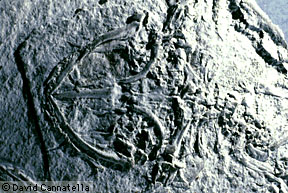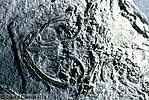Palaeobatrachidae
David Cannatella
- Albionbatrachus

- Lithobatrachus

- Neusibatrachus

- Palaeobatrachus

- Pliobatrachus

Introduction
The †Palaeobatrachidae is an extinct group of frogs. They lived principally from the Eocene through Pliocene in Europe, but some fossils are known from the Cretaceous (see below). Like pipids, they were highly aquatic. Even the tadpoles are well preserved as fossils! Their tadpoles lacked beaks and denticles (Type 1 tadpoles). Palaeobatrachids resemble pipids in many other features, such as elongate finger and toe bones, greatly expanded ilia (hip bones), and elongate, nonpedicellate fanglike teeth. However the vertebrae of these frogs were procoelous (articulating concavity on the anterior end) rather than opisthocoelous (articulating concavity posterior) as in pipids, and some of the vertebrae in the hip region were fused to form a synsacrum. Some taxa are known to have an additional bony element in the fourth finger and fifth toe (Estes and Reig, 1973). Some palaeobatrachids reached a size of 120 mm snout-vent length.
Discussion of Phylogenetic Relationships
Ford and Cannatella (1993) defined †Palaeobatrachidae as commonly used: the node-based name for the most recent common ancestor of †Palaeobatrachus, †Neusibatrachus, †Pliobatrachus, †Albionbatrachus, and †Lithobatrachus, and all of its descendants. Estes and Reig (1973) allied †Palaeobatrachidae to the Pipidae, and Cannatella (1985) and Cannatella and de Sá (1993) explicitly listed synapomorphies supporting this relationship. Estes and Reig (1973) distinguished †Palaeobatrachidae from Pipidae in having procoelous vertebrae (apomorphic), a synsacrum (apomorphic), and the presence of mentomeckelian bones (plesiomorphic). †Palaeobatrachus occidentalis (Estes and Sanchíz, 1982) from the Cretaceous of North America is known only from ilia, so its inclusion in †Palaeobatrachidae is somewhat tentative. Likewise, the Jurassic-Cretaceous fossil †Neusibatrachus (Seiffert, 1972) is procoelous, but lacks a synsacrum and some other features found in the Tertiary fossils.
References
Cannatella, D. C. 1985. A phylogeny of primitive frogs (archaeobatrachians). Ph.D. Dissertation, The University of Kansas, Lawrence.
Cannatella, D. C., and R. O. de Sa. 1993. Xenopus laevis as a model organism. Syst. Biol. 42(4):476-507.
Estes, R., and O. A. Reig. 1973. The early fossil record of frogs: a review of the evidence. Pp. 11-63 In J. L. Vial (Ed.), Evolutionary Biology of the Anurans: Contemporary Research on Major Problems. University of Missouri Press, Columbia.
Estes, R., and B. Sanchiz. 1982. New discoglossid and palaeobatrachid frogs from the Late Cretaceous of Wyoming and Montana, and a review of other frogs from the Lance and Hell Creek Formations. J. Vert. Paleo. 2(1):9-20.
Ford, L. S., and D. C. Cannatella. 1993. The major clades of frogs. Herp. Monogr. 7:94-117.
Seiffert, J. 1972. Ein Vorläufer der Froschfamilien Palaeobatrachidae und Ranidae im Grenzbereich Jura-Kreide. Neues Jahrb. Geol. PalÉont. Monatshefte 1972:120-131.
Title Illustrations

| Scientific Name | Palaeobatrachus |
|---|---|
| Comments | cast |
| Specimen Condition | Fossil |
| Image Use |
 This media file is licensed under the Creative Commons Attribution-ShareAlike License - Version 3.0. This media file is licensed under the Creative Commons Attribution-ShareAlike License - Version 3.0.
|
| Copyright |
© 1995 David Cannatella

|
About This Page
If you are interested in authoring or co-authoring the page for this taxon, or some part of it (even a species), contact David Cannatella.
David Cannatella

University of Texas, Austin, Texas, USA
Correspondence regarding this page should be directed to David Cannatella at
Page copyright © 1995 David Cannatella
 Page: Tree of Life
Palaeobatrachidae.
Authored by
David Cannatella.
The TEXT of this page is licensed under the
Creative Commons Attribution License - Version 3.0. Note that images and other media
featured on this page are each governed by their own license, and they may or may not be available
for reuse. Click on an image or a media link to access the media data window, which provides the
relevant licensing information. For the general terms and conditions of ToL material reuse and
redistribution, please see the Tree of Life Copyright
Policies.
Page: Tree of Life
Palaeobatrachidae.
Authored by
David Cannatella.
The TEXT of this page is licensed under the
Creative Commons Attribution License - Version 3.0. Note that images and other media
featured on this page are each governed by their own license, and they may or may not be available
for reuse. Click on an image or a media link to access the media data window, which provides the
relevant licensing information. For the general terms and conditions of ToL material reuse and
redistribution, please see the Tree of Life Copyright
Policies.
Citing this page:
Cannatella, David. 1995. Palaeobatrachidae. Version 01 January 1995 (under construction). http://tolweb.org/Palaeobatrachidae/16985/1995.01.01 in The Tree of Life Web Project, http://tolweb.org/








 Go to quick links
Go to quick search
Go to navigation for this section of the ToL site
Go to detailed links for the ToL site
Go to quick links
Go to quick search
Go to navigation for this section of the ToL site
Go to detailed links for the ToL site